|
Here are all the paintings of Albrecht Durer 03
| ID |
Painting |
Oil Pantings, Sorted from A to Z |
Painting Description |
| 63651 |
 |
Knight on Horseback |
1512 Drawing, 239 x 173 mm Biblioteca Pinacoteca Ambrosiana, Milan A preliminary study, drawn on both sides of the paper, for the masterly engraving of the Knight, Death and the Devil concentrates on the group comprising the horse and rider. From the proportional scheme drawn onto the sheet, it can be seen that D?rer precisely prepared the copper engraving in the same manner as his studies on the ideal proportions of the horse. While he did not change the depiction of the rider in the copper engravings, he altered details in the horse several times, for example correcting its right hind hoof both on the preliminary drawing and on the plate.Artist:D?RER, Albrecht Title: Knight on Horseback Painted in 1501-1550 , German - - graphics : study |
| 63599 |
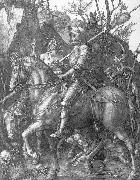 |
Knight, Death and the Devil |
1513 Engraving, 245 x 188 mm Staatliche Kunsthalle, Karlsruhe During 1513 and 1514 D?rer created the greatest of his copperplate engravings: the Knight, St Jerome in His Study, and Melencolia I - all of approximately the same size. The extensive, complex, and often contradictory literature concerning these three engravings deals largely with their enigmatic, allusive, iconographic details. Although repeatedly contested, it probably must be accepted that the engravings were intended to be interpreted together. There is general agreement, however, that D?rer, in these three master engravings, wished to raise his artistic intensity to the highest level, which he succeeded in doing. Finished form and richness of conception and mood merge into a whole of classical perfection. Knight, Death and the Devil, also known as The Rider, represents an allegory on Christian salvation. Unflustered either by Death who is standing in front of him with his hour-glass, or by the Devil behind him, an armoured knight is riding along a narrow defile, accompanied by his loyal hound. This represents the steady route of the faithful, through all of life's injustice, to God who is symbolized by the castle in the background. The dog symbolizes faith, and the lizard religious zeal. The horse and rider, like other preliminary studies made by D?rer, are derived from the canon of proportions drawn up by Leonardo da Vinci.Artist:D?RER, Albrecht Title: Knight, Death and the Devil Painted in 1501-1550 , German - - graphics : mythological |
| 82725 |
 |
Kopf eines bartigen Kindes |
1527
Medium Oil on canvas
Dimensions Deutsch: 52,5 x 27,8 cm
cyf |
| 42386 |
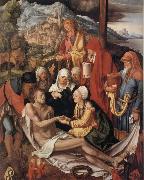 |
Lamentation for Christ |
mk168
151x121cm
Oil on coniferous wood
|
| 42387 |
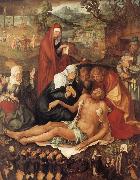 |
Lamentation for christ |
mk168
150x120
Oil on spruce
|
| 58704 |
 |
Lamentation for Christ |
Lamentation for Christ, oil, 1500-3 |
| 63741 |
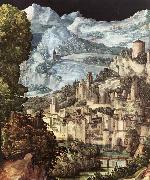 |
Lamentation for Christ |
1500-03 Oil on panel Alte Pinakothek, Munich This scene is framed above by a beautiful landscape in which Jerusalem can be seen off the lakeshore, atop a hill, in the foreground. Behind the city is a mountain peak and a mountain range that disappear into the background. The city, mountains, and lake are flooded with light. A thick blanket of heavy black clouds that thins out just above the lake in the back looms over the mountains. While the presence of the black clouds is justified by the narration of the crucifixion ("and darkness came over the whole land...while the sun's light failed," Luke 23:45), and the light is explained by the words of the apocryphal gospel of Saint Peter when he describes the position ("and the sun began to shine again ", 6:21), the Jerusalem that appears in the painting - a city near water, with house, towers, and fortification walls, lying against rocky mountains - is decidedly an invented, Nordic city, which does not at all reflect the actual appearance, well known at that time, of this blessed city.Artist:D?RER, Albrecht Title: Lamentation for Christ (detail) Painted in 1501-1550 , German - - painting : religious |
| 63742 |
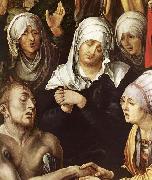 |
Lamentation for Christ |
1500-03 Oil on panel Alte Pinakothek, MunichArtist:D?RER, Albrecht Title: Lamentation for Christ (detail) Painted in 1501-1550 , German - - painting : religious |
| 63743 |
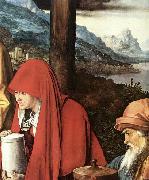 |
Lamentation for Christ |
1500-03 Oil on panel Alte Pinakothek, MunichArtist:D?RER, Albrecht Title: Lamentation for Christ (detail) Painted in 1501-1550 , German - - painting : religious |
| 63744 |
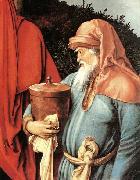 |
Lamentation for Christ |
1500-03 Oil on panel Alte Pinakothek, MunichArtist:D?RER, Albrecht Title: Lamentation for Christ (detail) Painted in 1501-1550 , German - - painting : religious |
| 63630 |
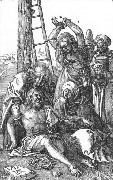 |
Lamentation over Christ |
1507 Engraving, 115 x 71 mm Metropolitan Museum of Art, New York Sheet No. 12 of the Engraved Passion. Also called Descent from the Cross, this is the first of D?rer's engravings after his return from Italy. It is not yet appreciably different in style from those of 1504/05. The Lamentation over Christ is the earliest of the plates of the Engraved Passion and considerably weaker than the other subjects of that series. It suffers from D?rer's preoccupation during this period with the arrangement of limbs. The position of Christ's legs is similar to that of the Infant Christ's in the painting The Brotherhood of the Rosary. D?rer could not have thought of an entire series of Passion subjects at that time, otherwise he would have begun with the Agony in the Garden. In contrast to the other subjects which were to follow, the background of this engraving is white.Artist:D?RER, Albrecht Title: Lamentation over Christ (No. 12) Painted in 1501-1550 , German - - graphics : religious |
| 1033 |
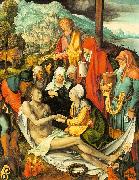 |
Lamentations Over the Dead Christ |
1500-03
Pinakothek, Munich |
| 63672 |
 |
Laughing Peasant Woman |
1505 Pen, 390 x 270 mm British Museum, London The legend reads: "una Villana vindisch" (a peasant woman in the Veneto). This shows the delicate short strokes of the time of The Life of the Virgin, still without more rigorous economy: a flow of little dashes, crossed here and there by patches of straight lines that extend beyond the outlines of the forms; a chiaroscuro effect. The transitory moment of the drawing back of the lips and the blinking of the eyes is captured and retained.Artist:D?RER, Albrecht Title: Laughing Peasant Woman Painted in 1501-1550 , German - - graphics : portrait |
| 42243 |
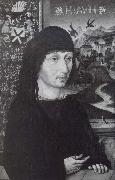 |
Levinus Memminger Michael Wolgemut |
mk168
335x230mm
|
| 42406 |
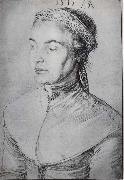 |
Likeness of a young girl |
mk168
423x294cm
|
| 42360 |
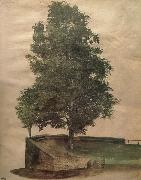 |
Linden Tree on a Bastion |
mk168
Watercolor and body color on vellum
343x267mm
|
| 43932 |
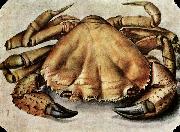 |
Lobster |
263 x 355 mm |
| 62447 |
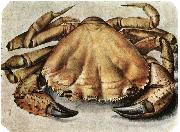 |
Lobster 1495 Watercolour and gouache |
263 x 355 mm Museum Boijmans Van Beuningen, Rotterdam The artist executed this watercolour during his first stay in Venice. The model was a living animal. Author: D?RER, Albrecht Title: Lobster , 1501-1550 , German Form: graphics , other |
| 63733 |
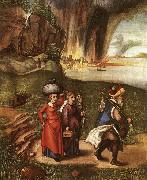 |
Lot Fleeing with his Daughters from Sodom |
1498 Oil and tempera on panel, 52 x 41 cm National Gallery of Art, Washington This delightfully spontaneous panel depicts Lot and his two daughters fleeing from the destruction of Sodom. In the story from Genesis, two angels warn Lot that he should escape before God destroys the city for its sins. Lot is told that his family must not look back, otherwise they will be turned into pillars of salt. In D?rer's panel, Lot leads the way, dressed in a warm fur-lined coat and a magnificent turban. He carries a basket of eggs and has a flask of wine slung over his shoulder on his stick. His two daughters follow several paces behind, one bearing a bundle on her head and the other with an elegant casket and a distaff and yarn. Far behind them, near the towering rocks, is Lot's wife, transformed into a brown pillar of salt. In the distance the town of Sodom explodes with brimstone and fire, huge columns of smoke belching up into the sky. Gomorrah, in the far distance, suffers a similar fate. This depiction of Lot's flight is not the main picture, but the reverse of a panel of the Virgin and Child. The two sides are quite different, not only in subject-matter but also in style. The Lot panel is painted in a loose, spontaneous manner, whereas the Virgin and Child is much more finely worked. However, D?rer must have intended them to be seen together. The panel was painted for the Nuremberg merchant family of Haller, whose arms appear in the bottom left corner of the panel of the Virgin. Virgin and Child at a Window was long assumed to be the work of the Venetian artist Giovanni Bellini, because of its composition and colouring. In 1934 it was identified as a D?rer, painted about three years after his return from Venice. It was bought by Baron Heinrich von Thyssen-Bornemisza, who owned it until 1950.Artist:D?RER, Albrecht Title: Lot Fleeing with his Daughters from Sodom Painted in 1501-1550 , German - - painting : religious |
| 42483 |
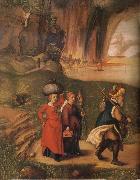 |
Lot flees with his family from sodom |
mk168
52x41cm
Oil on linden wood
|
| 67661 |
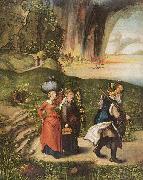 |
Loths Flucht |
c. 1496
Oil on panel
50,2 X 39,7 cm |
| 70119 |
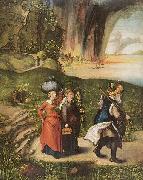 |
Loths Flucht |
Date Deutsch: um 1496
English: c. 1496
Medium Oil on panel
Dimensions Deutsch: 50,2 X 39,7 cm
|
| 63622 |
 |
Lucas van Leyden |
1521 Chalk and charcoal, 368 x 255 mm British Museum, London The legend (below left), "effigies Lucae Leidensis," is not by D?rer. The "L [Lucas] 1525" above it shows that the drawing was once given out to be a work of the Dutch artist. If that was incorrect, it still cannot be denied that in its calm physiognomy the drawing is close to the Dutch manner. The hair falling in strands is not stylised in D?rer's fashion. The whole piece is in the severe manner of the late period, with a strongly emphasized contrast between the fundamental horizontal and vertical directions. The background is dark and uniform.Artist:D?RER, Albrecht Title: "Lucas van Leyden" Painted in 1501-1550 , German - - graphics : portrait |
| 71625 |
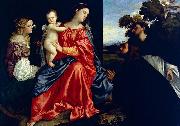 |
Madonna |
Date 1505
|
| 53758 |
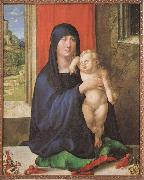 |
Madonna and child |
mk234
about 1505
40x50cm |
| 82519 |
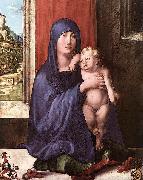 |
Madonna and Child |
Date ca. 1498(1498)
Medium Oil on wood
Dimensions Height: 50 cm (19.7 in). Width: 39 cm (15.4 in).
cjr |
| 85964 |
 |
Madonna and Child |
1498(1498)
Medium Oil on wood
cyf |
| 96923 |
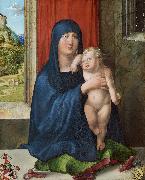 |
Madonna and Child |
circa 1498(1498)
Medium oil on panel
Dimensions 50 X 40 cm
cyf |
| 63604 |
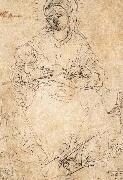 |
Madonna and Child on a Stone Bench |
1520 Pen drawing, 135 x 87 mm Pushkin Museum, Moscow This pen drawing is a preliminary study of the group of figures in an engraving, and while it shows the Madonna with her hair down, the babe in arms and folds of her garments are already very similarly depicted. The background landscape shown in the copper engraving is still omitted here.Artist:D?RER, Albrecht Title: Madonna and Child on a Stone Bench Painted in 1501-1550 , German - - graphics : study |
| 52032 |
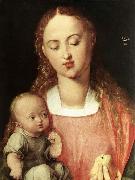 |
Madonna and Child with the Pear |
1526
Oil on wood,
43 x 32 cm |
| 1037 |
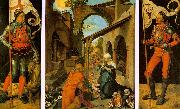 |
Madonna and Child _1 |
1512
Art History Museum, Vienna |
| 1046 |
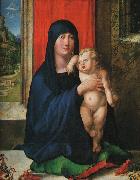 |
Madonna and Child_y |
1504-07
The National Gallery of Art, Washington DC |
| 63603 |
 |
Madonna by the Wall |
1514 Engraving, 149 x 101 mm Metropolitan Museum of Art, New York Critics call this the most perfect and rare of all of D?rer's engravings, assigning to it a special place among all of D?rer's plates. It is transitional from the technique of deep black lines to a more even-tempered, silvery mat texture. Its mood is almost tragic, akin to that of Melencolia I, perhaps because of the death of D?rer's mother, which occurred on May 14, 1514. Whereas the Madonna with the Monkey is pure black and white, the Madonna by the Wall shows a unique variety of texture resulting in a colouristic effect. The Madonna by the Wall represents a perfect coincidence of apparent opposites. Regal, virginal, yet humble and motherly. Its utmost precision of design is combined with incomparable softness of texture. The Infant Christ is here holding an apple (compare Madonna by the Tree). In the background appears the castle of Nuremberg, which D?rer could see from the windows of his house.Artist:D?RER, Albrecht Title: Madonna by the Wall Painted in 1501-1550 , German - - graphics : religious |
| 63614 |
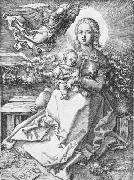 |
Madonna Crowned by an Angel |
1520 Engraving, 139 x 100 mm Metropolitan Museum of Art, New York According to D?rer's diary he gave away this Virgin as a present on four occasions. It is not as decidedly in the new style, but nevertheless distinguished by the new accent on frontality, exemplified by the youthful, idealized head. A peculiar impression is created by the white face and the concentration of the light on the skirt. It seems almost as if the scene were illuminated by lightning - the wind-blown hair, the creeping clouds, the upswept drapery of the angel - and in these surroundings sits the Virgin, smiling even though empty of expression, quite serene and aristocratic, idealized in the style of ancient, mild beauty. It can be noted its abstract rigidity, exemplified by the stiffly erect posture and the angular drapery, in all of which it surpasses the Madonna Crowned by Two Angels.Artist:D?RER, Albrecht Title: Madonna Crowned by an Angel Painted in 1501-1550 , German - - graphics : religious |
| 63607 |
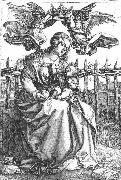 |
Madonna Crowned by Two Angels |
1518 Engraving, 148 x 100 mm Metropolitan Museum of Art, New York This is one of only two engravings of the period between 1514 and 1519. The Virgin is crowned with a wreath of roses and is holding an apple. In spite of its admirable style, it lacks warmth compared to earlier versions. The background is no longer picturesque but rather dry in its reality. D?rer made use of a much older preparatory study, originally sketched for the Heller Altarpiece, for the drapery of this engraving.Artist:D?RER, Albrecht Title: Madonna Crowned by Two Angels Painted in 1501-1550 , German - - graphics : religious |
| 63613 |
 |
Madonna Nursing |
115 x 73 mm Metropolitan Museum of Art, New York Michelangelesque monumentality and gloom here replace the Raphaelesque equilibrium of loveliness and solemnity of the Madonna Crowned by Two Angels. The group detaches itself from the solid background like sculpture projecting from a wall. The figure of the Virgin is composed of two block-like units, the lower one resembling an enormous cube. The emphasis is here shifted from linear values and dynamic movement to schematised volume.Artist:D?RER, Albrecht Title: Madonna Nursing Painted in 1501-1550 , German - - graphics : religious |
| 29925 |
 |
Madonna of the Pear |
mk67
Oil on panel
16 15/16x12 3/16in
Uffizi,Gallery
|
| 52018 |
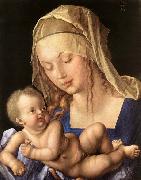 |
Madonna of the Pear |
1512
Oil on wood,
49 x 37 cm |
| 75656 |
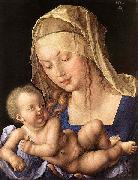 |
Madonna of the Pear |
1512
Oil on panel
49 ?? 37 cm
cjr |
| 63582 |
 |
Madonna on a Grassy Bench |
1503 Engraving, 115 x 70 mm Fogg Art Museum, Cambridge Except for The Four Witches, this is the first of D?rer's engravings to bear a date. Henceforth he dated them consistently. Vasari remarks that D?rer here "surpassed Martin Schongauer, as well as himself." This engraving, based on a preparatory drawing, is the most sensitive of the early Madonnas, quite in the convivial style of the Life of the Virgin woodcut series.Artist:D?RER, Albrecht Title: Madonna on a Grassy Bench Painted in 1501-1550 , German - - graphics : religious |
| 42261 |
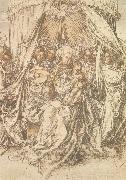 |
Madonna with musical Angels |
mk168
Pen and ink on paper with touches of watercolor
216x151mm
|
| 39700 |
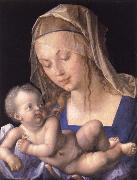 |
Madonna with the pear |
mk150
1512
49x37cm
|
| 88810 |
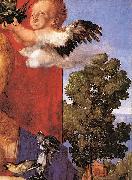 |
Madonna with the Siskin |
1506(1506)
Medium Oil on poplar
cyf |
| 63615 |
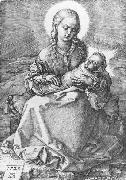 |
Madonna with the Swaddled Infant 1520 Engraving |
1520 Engraving, 144 x 97 mm Metropolitan Museum of Art, New York This late depiction of the Madonna and Child is almost genre-like. Only the halo indicates the holy nature of the group of figures. A human attitude is expressed in the loving way the mother is turning to her child, and this was intended to give the observer an emotional understanding of the Christian doctrine of salvation by encouraging "compassio," sympathy with the sufferings of Christ. D?rer recorded in his diary of the trip to the Low Countries that he gave away this print together with the Madonna Crowned by an Angel on four occasions (August 20, September 3, and late September 1520). Opinions of commentators vary greatly concerning this engraving. It could be noted that particularly great care was taken in the rendering of the hands of the Virgin and the head of Christ. The engraving is based or related to preliminary drawings.Artist:D?RER, Albrecht Title: Madonna with the Swaddled Infant Painted in 1501-1550 , German - - graphics : religious |
| 63643 |
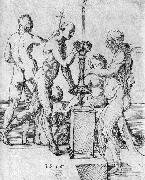 |
Male and Female Nudes |
1516 Pen, 258 x 225 mm St?delsches Kunstinstitut, Frankfurt (The significance of the action has not yet been convincingly explained.) This is a drawing of great lightness with open, quite transparent patches of strokes. The line that characterizes the form is completely absorbed in ornamental beauty. In the background, behind the lower third of the height of the figures, there is an area of parallel horizontal lines ?a feature that recurs elsewhere.Artist:D?RER, Albrecht Title: Male and Female Nudes Painted in 1501-1550 , German - - graphics : study |
| 53760 |
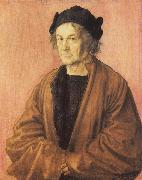 |
Male father |
mk234
1497
50x40cm |
| 63669 |
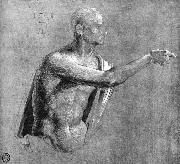 |
Male Nude |
1508 Brush drawing with white highlights on dark paper, 198 x 216 mm Kunsthalle, Bremen Study for the Christ in the Heller Altar.Artist:D?RER, Albrecht Title: Male Nude, Half-length Painted in 1501-1550 , German - - graphics : study |
| 63646 |
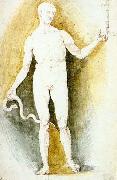 |
Male Nude with a Glass and Snake |
so-called Asclepius c. 1500 Pen drawing, green ink, 325 x 205 mm Staatliche Museen, Berlin This pen drawing of the so-called Asclepius, the classical god of medicine, is one of D?rer's earliest studies of proportion. The design sketch proves that the figure was originally laid out as a study of proportion. The muscular detail of the body is similar to that of Adam in the copper engraving dating from 1504.Artist:D?RER, Albrecht Title: Male Nude with a Glass and Snake, so-called Asclepius Painted in 1501-1550 , German - - graphics : study |
| 42289 |
 |
Man |
mk168
age ninety-three
415x252mm
|
| 63575 |
 |
Man of Sorrows by the Column |
1509 Engraving, 116 x 75 mm Metropolitan Museum of Art, New York Sheet No. 1 of the Engraved Passion. Generally considered the frontispiece of the Engraved Passion. This print opens the Passion series, although it is not historical but a representation outside the Gospels. As such, it probably derives from Passion plays. In this version Christ is shown standing. Later, D?rer found the sitting position preferable and used it for the frontispieces of his woodcut Passions. The combination of the Man of Sorrows with the Virgin and St John was already used by Schongauer. The iconography is based on a vision experienced by St Bridget. The arrangement of the bystanders in half-length is quite new and remarkable. After this work D?rer suspended his engraving activity until 1511 and suddenly returned to producing a series of woodcuts after a lapse of more than five years. He issued more than thirty of the thirty-seven subjects of the Small Woodcut Passion during this period. The complete series was published in 1511. At the same time D?rer finally completed the Heller Altarpiece. In 1510 D?rer also prepared the additional sheets of the Large Woodcut Passion and the [woodcut] Life of the Virgin.Artist:D?RER, Albrecht Title: Man of Sorrows by the Column (No. 1) Painted in 1501-1550 , German - - graphics : religious |
| 82800 |
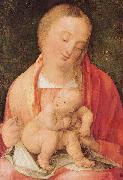 |
Maria mit dem hockenden Kind |
1516
Medium Oil on panel
Dimensions Deutsch: 27,9 x 20,5 cm
cyf |
| 78906 |
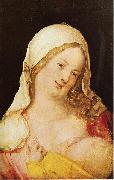 |
Maria mit dem Kind |
English: c. 1500-1503
Medium Oil on panel
Dimensions Deutsch: 24 x 18 cm
cyf |
| 76640 |
 |
Maria mit Kind |
1526(1526)
Oil on panel
43 ?? 32 cm
cjr |
| 77463 |
 |
Maria mit Kind |
Date 1512
Medium Oil on panel
Dimensions 49 ?? 37 cm
cyf |
| 78528 |
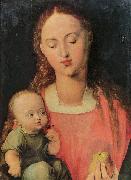 |
Maria mit Kind |
1526(1526)
Medium Oil on panel
Dimensions Deutsch: 43 x 32 cm
cyf |
| 88634 |
 |
Maria mit Kind |
c. 1496
Medium Oil on canvas
Dimensions Deutsch: 95 x 105,5 cm
cjr |
| 82815 |
 |
Maria mit Kind vor einem Torbogen |
English: c. 1494-1497
Medium Oil on panel
Dimensions 47,8 x 36 cm
cyf |
| 78762 |
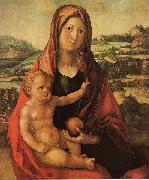 |
Maria mit Kind vor einer Landschaft |
c. 1494-1497
Oil on panel
89 x 74 cm
cjr
|
| 81866 |
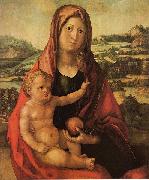 |
Maria mit Kind vor einer Landschaft |
Oil on panel
Deutsch: Pappelholz
Dimensions Deutsch: 89 x 74 cm
cyf |
| 39695 |
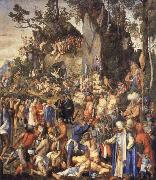 |
Martyrdom of the 10000 Christians |
mk150
99x87cm
|
| 1041 |
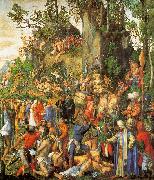 |
Martyrdom of the Ten Thousand |
1508
Art History Museum, Vienna |
| 63573 |
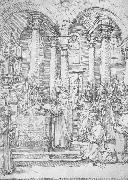 |
Mass |
307 x 221 mm Staatliche Museen, Berlin The late date is justified by the simplified and strictly planar representation. Depth of field is not lacking, but occurs only in a regular succession of planes, The drawing also has interest for historians of architecture: an arcade with columns that have an intermediate entablature above their capitals. The connection between this and the transverse column pairs in the side aisle (which breaks down into isolated bays) is unclear. The geminate altarpiece is in pure (North Italian) Renaissance style.Artist:D?RER, Albrecht Title: Mass Painted in 1501-1550 , German - - graphics : study |
| 63662 |
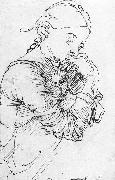 |
mein Agnes |
1494 Pen drawing in bistre on white paper, 156 x 98 mm Graphische Sammlung Albertina, Vienna When D?rer finally returned to Nuremberg in May 1494 he was 23, fully-trained and could open his own workshop. Albrecht the Elder had felt it was time for his son to marry and had chosen a wife during his long absence. On 7 July, just a few weeks after his return, D?rer was married to Agnes Frey, the daughter of the skilled and prosperous coppersmith Hans Frey and his wife Anna Rummel. It was probably just before their wedding that D?rer sketched his fianc?e, then in her late teens. Capturing her pensive mood with just a few strokes of the pen, D?rer lovingly inscribed it: `My Agnes'. Agnes, who still appears girlish, even childlike, here, is sitting at a table and supporting her head pensively on her right hand, her hair tied back. The intimacy of this everyday sketch is unusual, showing the depicted woman at a moment when she evidently thought herself to be unobserved.Artist:D?RER, Albrecht Title: "mein Agnes" Painted in 1501-1550 , German - - graphics : portrait |
| 44876 |
 |
Melancholia |
mk176
9.5x7.5
|
| 25938 |
 |
Melancholia I (MK45) |
1514
Copperplate engraving
23.9X16.8cm
Berlin,Staatliche Museen zu Berlin-Preubischer Kulturbesitz,Kupferstichkabinett
|
| 42422 |
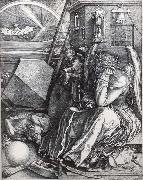 |
Melencolia I |
mk168
240x186mm
|
| 42403 |
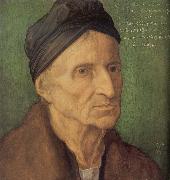 |
Michael Wolgemut |
mk168
29x27cm
Oil on linden wood
|
| 42238 |
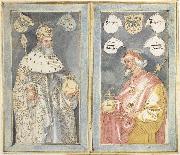 |
Model for the Portraits of the Emperors |
mk168
Pen and ink on paper,with watercolor
London
|
| 84293 |
 |
Mother of Sorrows |
Date ca. 1496(1496)
Medium Oil on pine panel
Dimensions Height: 109.2 cm (43 in). Width: 43.3 cm (17 in).
cjr |
| 42380 |
 |
Nemesis |
mk168
325x232mm
|
| 63580 |
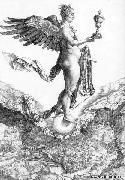 |
Nemesis or Good Fortune |
1502 Engraving, 332 x 232 mm Staatliche Kunsthalle, Karlsruhe This engraving was created between 1501 and 1503 and was one of D?rer's main large format engravings. The female figure is derived from the poem Manto by the Italian poet and humanist Poliziano, which D?rer presumably became acquainted with when studying in the library of his humanist friend, Willibald Pirckheimer. The poem combines the goddesses of Revenge and Fate. The female shape is floating along above the clouds on a globe and with eagle wings, holding a goblet in her right hand and bridle in her left. She is the result of D?rer's studies of Vitruvius' proportions. Copies of this print were frequently given as presents by D?rer during his trip to the Netherlands during 1520-21. Vasari describes it as "a nude figure floating in the clouds, representing Temperance, with magnificent wings, a golden cup and reins in her hands." The reins signify restraint from temptation that should be exercised by man; the sphere uncertainty. The figure is proportioned according to the canon of Vitruvius. The landscape below has been identified as the village of Klausen (Chiusa) in the Valle d'Isarco in the Tyrol, which lay on D?rer's route of travel to Venice.Artist:D?RER, Albrecht Title: Nemesis or Good Fortune Painted in 1501-1550 , German - - graphics : mythological |
| 42321 |
 |
Nude Seen From Behind |
mk168
283x224mm
|
| 42320 |
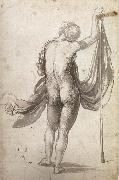 |
Nude With Staff seen from behind |
mk168
320x210mm
|
| 63686 |
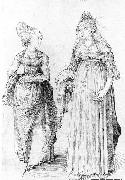 |
Nuremberg and Venetian Women |
1496-97 Pen drawing on paper, 241 x 160 mm St?delsches Kunstinstitut, Frankfurt This pen drawing is an eloquent example of D?rer's interest in costumes, which he here places side by side comparatively. The two women, one from Nuremberg and one from Venice, appear as if they were taking a stroll together in Venice. The lavish ornamentation and low neckline of the liberal, pretty Venetian costume contrasts with the modest, simple dress of the Nuremberg woman.Artist:D?RER, Albrecht Title: Nuremberg and Venetian Women Painted in 1501-1550 , German - - graphics : other |
| 42374 |
 |
Nuremberg Seen From the south |
mk168
163x344mm
|
| 63641 |
 |
Nuremberg Woman Dressed for Church |
1500 Pen and ink and watercolour on paper, 325 x 218 mm Graphische Sammlung Albertina, Vienna D?rer, who seems to have dressed well himself, was always interested in depicting clothing and he produced some of the earliest known costume studies in European art. This is one of a set of four costume studies of Nuremberg women, two of them in dancing dresses and one in everyday attire. The artist's wife Agnes; then in her mid-twenties, was probably the model. The watercolour is inscribed: `This is how people dress for church in Nuremberg' along with the text `Think of me in Thy Realm'. Dressed in her best clothes for church, the demure young woman wears a red cloak with a green lining and beneath this is a blue-green dress fringed with white fur. She has a starched linen headdress. Her eyes look down at the ground, in a contemplative pose. Four years later D?rer used this study in his woodcut of the Marriage of the Virgin. The Nuremberg woman appears at the right of the print, in reverse, as one of the seven virgins who were Mary's companions.Artist:D?RER, Albrecht Title: Nuremberg Woman Dressed for Church Painted in 1501-1550 , German - - graphics : other |
| 42400 |
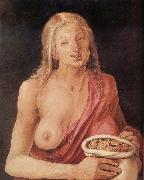 |
Old woman with Bag of coins |
mk168
35x29cm
Oil on linden wood
|
| 42247 |
 |
One of the Foolish Virgins |
mk168
120x84mm
|
| 42249 |
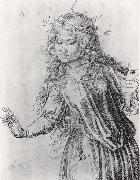 |
one of the wise virgins |
mk168
292x203mm
|
| 30942 |
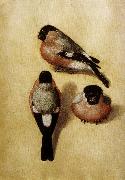 |
Parrot in Three Positions |
mk68
c.1500
|
| 52023 |
 |
Paumgartner Altar |
c. 1503
Oil on lime panel,
151 x 61 cm |
| 52024 |
 |
Paumgartner Altar |
c. 1503
Oil on lime panel,
155 x 126 cm |
| 52025 |
 |
Paumgartner Altar |
c. 1503
Oil on lime panel Alte Pinakothek |
| 63745 |
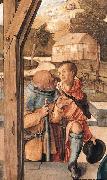 |
Paumgartner Altar |
1503 Oil on lime panel Alte Pinakothek, Munich In the background, an old and young shepherd, deep in conversation, are stepping up to the holy scene. As the old shepherd stretches out his hand in a rhetorical gesture, the other one turns towards him. The foreshortened frontal view of the young shepherd indicates Italian models such as Andrea Mantegna and others whose works D?rer had encountered during his first Italian journey.Artist:D?RER, Albrecht Title: Paumgartner Altar (detail of central panel) Painted in 1501-1550 , German - - painting : religious |
| 63746 |
 |
Paumgartner Altar |
1503 Oil on lime panel, 151 x 61 cm Alte Pinakothek, Munich The side wings depict St George on the left and St Eustace on the right, complete with their attributes on their banners as recorded in the Legenda aurea. St George was a crusader and had liberated the Libyan town of Silena from the dragon, while the Crucified Christ had appeared to St Eustace in a forest in the antlers of a stag, thus converting him to Christianity. The donors themselves appear in the form of their personal saints. On the left, facing the central panel, Stephan Paumgartner appears as St George, and on the right Lukas Paumgartner appears as St Eustace. Both are wearing splendid knightly armor. They are Christian knights, guards and protectors of the holy shrine, the Nativity of Christ in the central panel where they appear once more as part of the group of the donating family.Artist:D?RER, Albrecht Title: Paumgartner Altar (right wing) Painted in 1501-1550 , German - - painting : religious |
| 92011 |
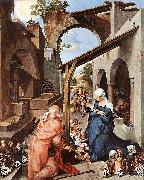 |
Paumgartner Altar |
1503(1503)
Medium oil on linden
Dimensions Height: 155 cm (61 in). Width: 126 cm (49.6 in).
cyf |
| 1036 |
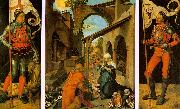 |
Paumgartner Altarpiece |
1498-1504
Pinakothek, Munich |
| 40282 |
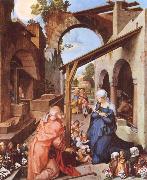 |
Paumgatner Altar |
mk156
1502-04
Oil on lime panel
155x126cm
|
| 42340 |
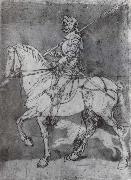 |
Peaparatory study for the engraving |
mk168
246x185mm
|
| 63600 |
 |
Peasant Couple Dancing |
118 x 75 mm Metropolitan Museum of Art, New York In spite of the elephantine stamping of their feet, the impression and the form are magnificent. The peasants are not shown sneeringly as earlier, but as a character study.Artist:D?RER, Albrecht Title: Peasant Couple Dancing Painted in 1501-1550 , German - - graphics : genre |
| 42313 |
 |
Peasants at Market |
mk168
116x73mm
|
| 63626 |
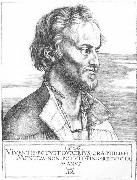 |
Philipp Melanchthon |
1526 Engraving, 174 x 127 mm Museum of Fine Arts, Boston Philipp Melanchthon (1497-1560) was one of the great humanists of his age. He was the German author of the Confession of Augsburg of the Lutheran Church (1530), humanist, reformer, theologian, and educator. His original name Philipp Schwartzerd means Black Earth in German, in Greek, Melanchthon. After studying in Heidelberg and T?bingen, he taught as a professor in Wittenberg. The main emphasis of his research was on theology, philosophy and rhetoric. In 1521 Melanchthon published the Loci communes, the first systematic treatment of evangelical doctrine. Because of his academic expertise he was asked to help in founding schools, and he virtually reorganized the whole educational system of Germany, founding and reforming several of its universities. In November 1525 and May 1526 he visited Nuremberg at the invitation of the city council in order to establish the first public school. Melanchthon is facing to the right in a striking three quarter profile. The epitaph-like Latin inscription refers to the humanist discussion Melanchthon led on the portrayability of the human character: "1526. Viventis potuit Dvreris Ora Philippi Mentem non Potuit Pingere Docta Manus" (1526. D?rer was able to draw the features of Philipp from life, but his expert hand could not capture his spirit. A.D.). It can be pointed out that the reflection of a window in the eyes verges on the ridiculous in this case, as the indication of clouds in the background show that Melanchthon is supposed to be standing in the open air.Artist:D?RER, Albrecht Title: Philipp Melanchthon Painted in 1501-1550 , German - - graphics : portrait |
| 42343 |
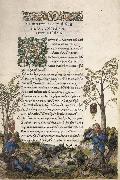 |
Pige Decoration for WIllibald Pirckheimer |
mk168
300x210mm
|
| 42449 |
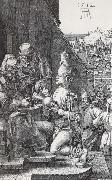 |
Pilate Washing his Hands |
mk168
1512
117x75mm
|
| 42466 |
 |
Piper and Drummer |
mk168
94x51cm
Oil on linden wood
|
| 82967 |
 |
Portra des Kaisers Maximilians I |
1519
Medium Oil on panel
cyf |
| 82923 |
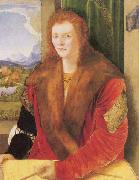 |
Portra eines Unbekannten mit roter Schaube |
Oil on panel
Dimensions Deutsch: 52 x 40 cm
cyf |
| 42494 |
 |
Portrait of a boy with a long beard |
mk168
552x278mm
Watercolor on canvas
|
| 42404 |
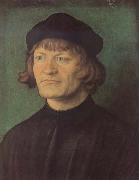 |
Portrait of a Clergyman |
mk168
41.5x33cm
Oil on vellum
Mounted on wood
|
| 63666 |
 |
Portrait of a Girl |
1515 Charcoal, 420 x 290 mm Staatliche Museen, Berlin It has been conjectured that the girl, whose eyes are not open equally wide and who has a somewhat sleepy expression, was a relative of D?rer's wife.Artist:D?RER, Albrecht Title: Portrait of a Girl Painted in 1501-1550 , German - - graphics : portrait |
|
|
|
Prev 1 2 3 4 5 6 7 Next
|
|
| Albrecht Durer
|
| b.May 21, 1471, Imperial Free City of Nernberg [Germany]
d.April 6, 1528, Nernberg
Albrecht Durer (May 21, 1471 ?C April 6, 1528) was a German painter, printmaker and theorist from Nuremberg. His still-famous works include the Apocalypse woodcuts, Knight, Death, and the Devil (1513), Saint Jerome in his Study (1514) and Melencolia I (1514), which has been the subject of extensive analysis and interpretation. His watercolours mark him as one of the first European landscape artists, while his ambitious woodcuts revolutionized the potential of that medium. D??rer introduction of classical motifs into Northern art, through his knowledge of Italian artists and German humanists, have secured his reputation as one of the most important figures of the Northern Renaissance. This is reinforced by his theoretical treatise which involve principles of mathematics, perspective and ideal proportions.
His prints established his reputation across Europe when he was still in his twenties, and he has been conventionally regarded as the greatest artist of the Renaissance in Northern Europe ever since.
|
|


